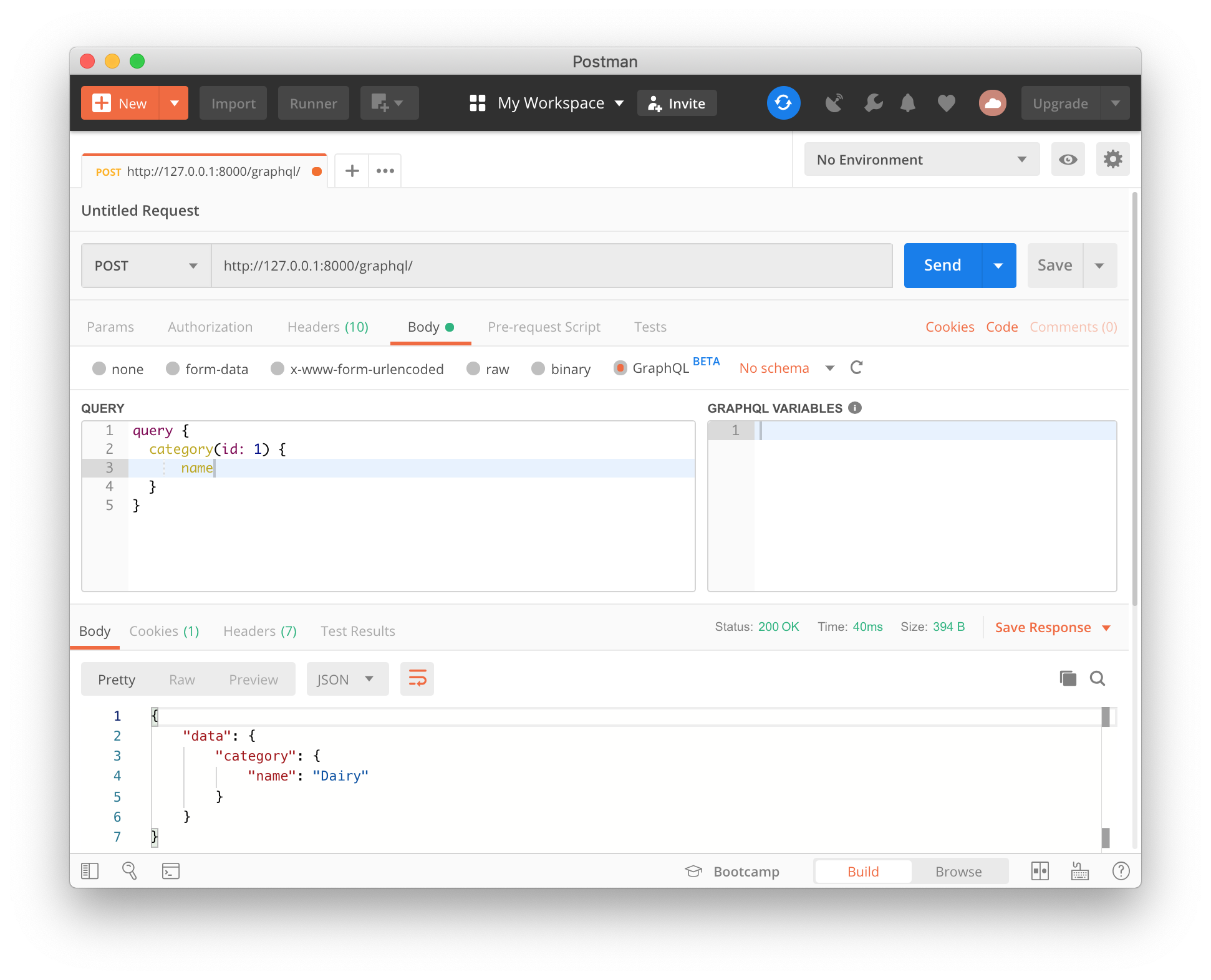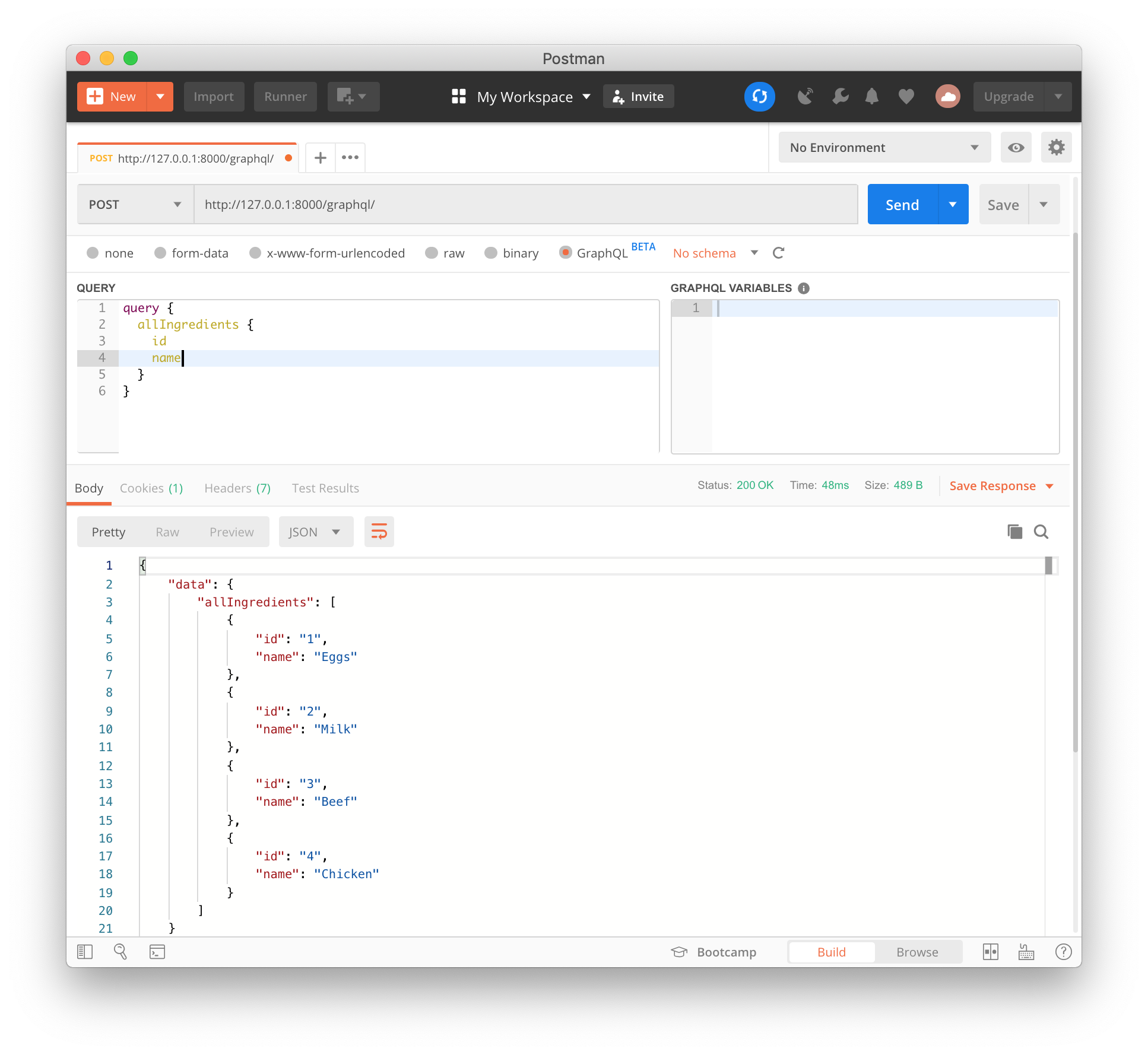

... visits
내가 가장 좋아하고, 가장 많이 사용하는 프로그래밍 언어인 Python으로 GraphQL 서버를 구현하면서 GraphQL에 대해 자세히 공부해 보자.
awesome-graphql Python 라이브러리 목록에서 클라이언트 구현을 제외하고, GraphQL 스키마와 타입을 구현하기 위한 라이브러리를 먼저 살펴봤다.
.graphql 파일에 정의한 스키마를 로딩할 수 있다.Apollo 서버와 Ariadne 같은 경우 스키마 우선 접근에 속한다고 할 수 있는데, 반해 Graphene은 코드 우선 접근 방식을 사용하고 있다. 즉, SDL(Schema Definition Language)를 사용하는 대신 파이썬 코드로 데이터를 표현한다는 의미이다.
Graphene은 유명 프레임워크와 ORM과 쉽게 통합할 수 있고, 스키마 정의와 Relay-Compliant API를 구축하기 위한 도구와 패턴들을 제공한다.
▶︎ 파이썬 환경에 PIP를 이용한 graphene 라이브러리 설치
$ pip install "graphene>=2.0"
다음과 같은 쿼리를 GraphQL 서비스로 전송한다고 가정해 보자.
{
hello(name: "jonnung")
}
이 쿼리는 GraphQL 서비스가 갖는 단일 Endpoint(예:/graphql/)로 전달되며, root type인 Query 스키마에 의해 검증될 것이다. Query 스키마를 SDL(Schema Definition Language)로 표현하면 아래와 같다.
type Query {
hello(name: String = "anonymous"): String
goodbye: String
}
GraphQL 서비스가 이 쿼리를 처리한 후 반환된 결과값에는 우리가 요청한 필드 값만 포함될 것이라는 것을 예상할 수 있다.
# HTTP 응답 결과
{
"data": {
"hello": "Hello jonnung!"
}
}
GraphQL 명세에 의하면 모든 스키마는 객체 타입(object type)으로 구성되고, 이 객체는 필드(field)를 포함한다.
필드의 타입은 string, integer 등과 같은 스칼라 타입이거나 열거형(enum) 타입이 될 수 있다. 그리고 필드는 인자(argument)를 받을 수 있으며, 인자에 대한 타입과 기본 값을 지정할 수 있다.
# example.py
from graphene import ObjectType, String, Schema
class Query(ObjectType):
hello = String(name=String(default_value='anonymous'))
goodbye = String()
schema = Schema(query=Query)
요청한 쿼리에 데이터를 가져오기 위해 스키마의 각 필드마다 Resolver 함수를 구현해야 한다.
Resolver 함수는 resolve_<필드명> 같은 이름을 가진 Query 클래스의 메서드로 정의한다.
# example.py
from graphene import ObjectType, String, Schema
class Query(ObjectType):
hello = String(name=String(default_value='anonymous'))
goodbye = String()
def resolve_hello(self, info, name):
return f'Hello {name}!'
def resolve_goodbye(self, info):
return 'Bye~'
schema = Schema(query=Query)
result = schema.execute(’{ hello }’) print(result.data[‘hello’])
result_with_arg = schema.execute(’{ hello(name: “jonnung”) }’) print(result_with_arg.data[‘hello’])
result_goodbye = schema.execute(’{ goodbye }’) print(result_goodbye.data[‘goodbye’])
<br/>
# Django와 Graphene 연동하기
> ⚠️ 이 내용은 [Graphene-Django의 공식 튜토리얼](https://docs.graphene-python.org/projects/django/en/latest/tutorial-plain/)을 기반으로 정리된 내용이다. 하지만 핵심적인 부분만 다루기 위해 약간 변경한 부분이 존재한다.
### Django 프로젝트 준비
> ❗️ 편의상 Django에 대한 기본적인 개념과 구조를 이해하고 있다는 것을 전제로 하고 있다. (이건 공식 튜토리얼도 마찬가지...)
먼저 새로운 Django 프로젝트를 생성하고, 간단한 **모델 클래스**를 정의한다.
```bash
# Django 설치
$ pip install Django
# Graphene Django 설치
$ pip install graphene-django
# 새로운 Django 프로젝트
$ django-admin startproject cookbook
# 새로운 Django 앱 추가
$ cd cookbook;
$ django-admin startapp ingredients
이 모델 클래스는 요리책(cookbook)에 대한 재료(ingredients)와 분류(category)에 대한 모델을 정의하고 있다.
# 모델 클래스 정의하기
# ingredients/models.py
from django.db import models
class Category(models.Model):
name = models.CharField(max_length=100)
def __str__(self):
return self.name
class Ingredient(models.Model):
name = models.CharField(max_length=100)
notes = models.TextField()
category = models.ForeignKey(
Category, related_name='ingredients', on_delete=models.CASCADE)
def __str__(self):
return self.name
위에서 설명 했지만 스키마의 root type은 모든 쿼리의 진입점(Endpoint)이 된다. 이 root type은 Query와 Mutation 중 중 하나가 될 수 있다.
여기서 살펴볼 스키마는 Query 타입을 가진 query 필드이며, Query 타입은 하위 필드를 갖는 객체 타입(object type)이다.
schema {
query: Query
}
type Query {
all_categories: [CategoryType]
all_ingredients: [IngredientType]
}
이제 이 SDL에서 Django와 Graphene을 이용해 구현해 보자.
먼저 Django 프로젝트-레벨(cookbook)에 schema.py 모듈을 추가하고 graphene.ObjectType 상속한 Query 클래스를 정의한다. 이 Query 클래스가 GraphQL의 root type이 된다.
그리고 Query 클래스는 Django 앱-레벨(igredients)에 있는 schema.py 모듈에 정의된 Query 클래스(ingredients.schema.Query)를 다중 상속하는 Mixin 클래스가 된다.
# cookbook/schema.py
import graphene
from cookbook.ingredients.schema import Query as IngredientsQuery
class Query(IngredientsQuery, graphene.ObjectType):
pass
schema = graphene.Schema(query=Query)
# ingredients/schema.py
import graphene
from graphene_django.types import DjangoObjectType
from ingredients.models import Category, Ingredient
class CategoryType(DjangoObjectType):
class Meta:
model = Category
class IngredientType(DjangoObjectType):
class Meta:
model = Ingredient
class Query(object):
category = graphene.Field(CategoryType,
id=graphene.Int(),
name=graphene.String())
all_categories = graphene.List(CategoryType)
ingredient = graphene.Field(IngredientType,
id=graphene.Int(),
name=graphene.String())
all_ingredients = graphene.List(IngredientType)
def resolve_all_categories(self, info, **kwargs):
return Category.objects.all()
def resolve_all_ingredients(self, info, **kwargs):
return Ingredient.objects.all()
def resolve_category(self, info, **kwargs):
id = kwargs.get('id')
name = kwargs.get('name')
if id is not None:
return Category.objects.get(pk=id)
if name is not None:
return Category.objects.get(name=name)
return None
def resolve_ingredient(self, info, **kwargs):
id = kwargs.get('id')
name = kwargs.get('name')
if id is not None:
return Ingredient.objects.get(pk=id)
if name is not None:
return Ingredient.objects.get(name=name)
return None
이렇듯 실제 애플리케이션들에 정의된 스키마(schema.py)를 최상위 root type 스키마가 포함하게 되는 것이다.
Graphene은 이것을 Python 클래스를 기반으로 구현하기 위해 다중 상속을 이용한 것이고, 하위 스키마(부모 클래스)가 늘어날수록 관리측면에서 여러모로 불편함과 비용이 발생할 것 같다는 생각이 든다.
GraphQL은 단일 진입점(endpoint)를 갖기 때문에 보통 /graphql/ 이라는 하나의 URL Path로만 쿼리를 받는다.
그래서 /graphql/ 경로를 Django가 받도록 설정해야 하므로 cookbook/urls.py 모듈에 urlpatterns 변수를 수정한다.
아래 코드에서는 원문 튜토리얼과 다르게
graphiql
사용하지 않게 설정 해봤고 대신 CURL이나 Postman을 이용해 HTTP 요청을 보낼 수 있도록 CSRF 토큰을 검증하지 않게 설정했다.
(GraphQLView 클래스에 dispatch 함수가 ensure_csrf_cookie 데코레이터를 통해 CSRF 토큰을 강제하고 있기 때문에 이를 우회하기 위한 방법이다.)
# cookbook/urls.py
from django.contrib import admin
from django.urls import path
from django.views.decorators.csrf import csrf_exempt
from graphene_django.views import GraphQLView
urlpatterns = [
path('admin/', admin.site.urls),
path(r'graphql/', csrf_exempt(GraphQLView.as_view()))
]
다음으로 GraphQLView Django View 클래스로 전달받은 쿼리를 검증하기 위해 GraphQL 스키마를 지정 해줘야 한다.
가장 간단한 방법은 urls.py 모듈에서 Django View 클래스에 호출한 .as_view(schema=schema)에 schema 키워드 인자를 전달하면 된다.
아니면 (공식 튜토리얼대로) settings.py 모듈에 GRAPHENE 변수를 선언하고, dict 타입으로 “SCHEMA"를 명시할 수 있다.
# cookbook/settngs.py
GRAPHENE = {
'SCHEMA': 'cookbook.schema.schema'
}
위에서 언급한 대로 CURL, HTTPie 또는 Postman을 통해 /graphq/ 을 호출할 수 있다.
▶︎ Postman을 이용해서 GraphQL 호출하기 ( v7.2 부터 GraphQL 지원 👍*)*


Python으로 GraphQL 서버를 구축해야 한다면 그나마 Graphene이 가장 보편적인 선택일 수 있을 것 같다.
그 이유는 너무나 유명한 Django, Flask 같은 웹 프레임워크와 통합이 잘 제공되고, ORM을 사용한다면 정의한 GraphQL 스키마와 거의 1:1 매칭이 가능하다는 편의성을 들 수 있을 것 같다.
하지만 SDL을 Python 클래스로 구현해야 하는 것은 중복 비용일 것 같다는 것과 최상위 스키마(Query)에서 다중 상속하는 방식은 그다지 깔끔 해보이지는 않는다고 생각한다.
어쨌든 나는 계속 Python으로 GraphQL에 대한 탐구와 시도를 이어갈 예정이기 때문에 실제 서비스로 적용하는 것을 목표로 하고 있다. 끝